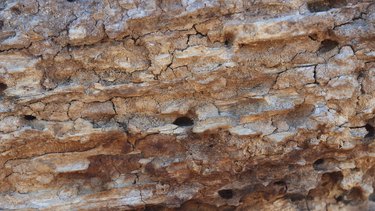
Wood-boring beetles are small, but they can certainly do a lot of damage. One species is the cedar bark beetle, which can attack branches, twigs or entire cedar trees (Cedrus spp.). If you have these, you will want to know how to kill wood-boring beetles in cedar trees. They are not hard to find, but if enough damage is already done, the whole tree may die. There are ways to stop the infestation, but it must be done properly with the appropriate safety precautions.
Wood-Boring Beetle Behavior
Video of the Day
These beetles are about 1/8 inch long (close to the size of a grain of rice) and are reddish-brown to black in color. Their larvae look like legless, whitish grubs that have brown head capsules. Cedar bark beetles are attracted to trees that are weakened by soil compaction, drought, animal damage and breakage.
Video of the Day
Once they are in a tree, boring beetles feed on twigs and hollow them out. You may see dead twig and branch tips, called "flagging," throughout the cedar tree's crown. Things can get much worse if the beetles colonize the trunk and branches and produce offspring under the bark. This can cause major damage or death for the tree.
In addition to flagging, other signs include the tree's top fading from green to yellow to reddish-brown. There may also be boring dust, which can be seen in and around the base of the tree and in bark crevices. Also look for wishbone or J-shaped tunnels in the bark or holes in the branches and trunks. If the top of the tree has turned red, the beetles may have already left to find another host.
Treating Cedar Beetle Infestation
The treatment for all boring beetles is pretty much the same. If the tree is past salvation, it should be cut down and its roots pulled out of the ground. If it is not large, it could be cut up and then chipped, burned or buried. If choosing the latter method, it should be buried at least 8 inches underground and away from any other cedar trees or juniper trees.
There are treatments like insecticides that can be used to protect cedar trees from these beetles. It can be applied to the tree's branches, twigs and trunk. When using this treatment, it is important not to drench the tree. If you detect holes or tunnels in the wood, switch to the product's pin stream setting and saturate the visible openings.
As a preventive measure, you can spray the tree with carbaryl in the spring through the end of summer since this is when the adult beetles are typically present. Spray the wood and any new green stems that are bigger than 1 inch. You may also want to set out pheromone traps on your property but keep these away from the trees. One of the best ways to protect your home or your trees is to keep infested wood away, whether it comes from wood furniture or split wood for a fire.
Essential Safety Precautions
No one ever wants to remove a tree, but it may be necessary to do so if it is dead or dying. This is often best left to professionals, especially if the tree is large. Smaller trees may be taken down with a chainsaw, but this is only recommended for those who are familiar with the tool.
Be sure to wear appropriate safety gear whether you are removing the tree or treating it. This includes safety glasses, safety gloves and sturdy shoes. Also, remember to read the directions on the insecticide container's label before getting started.